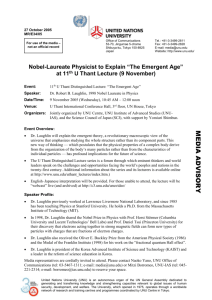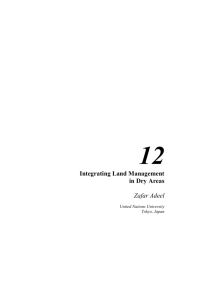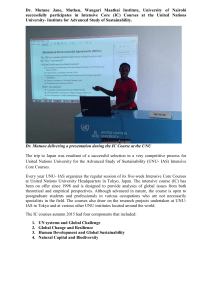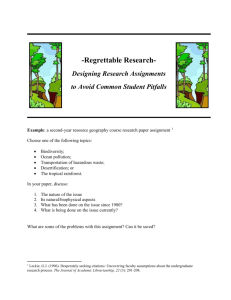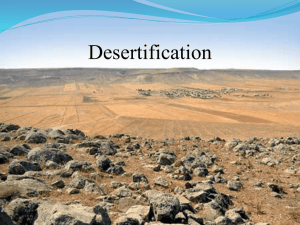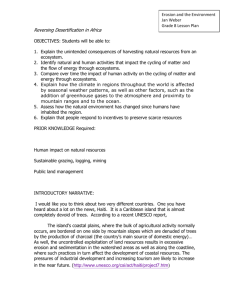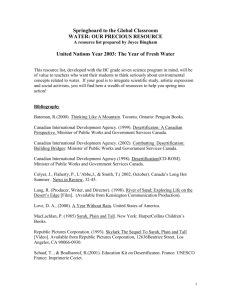The United Nations University and Its Role in Desertification Issues
advertisement
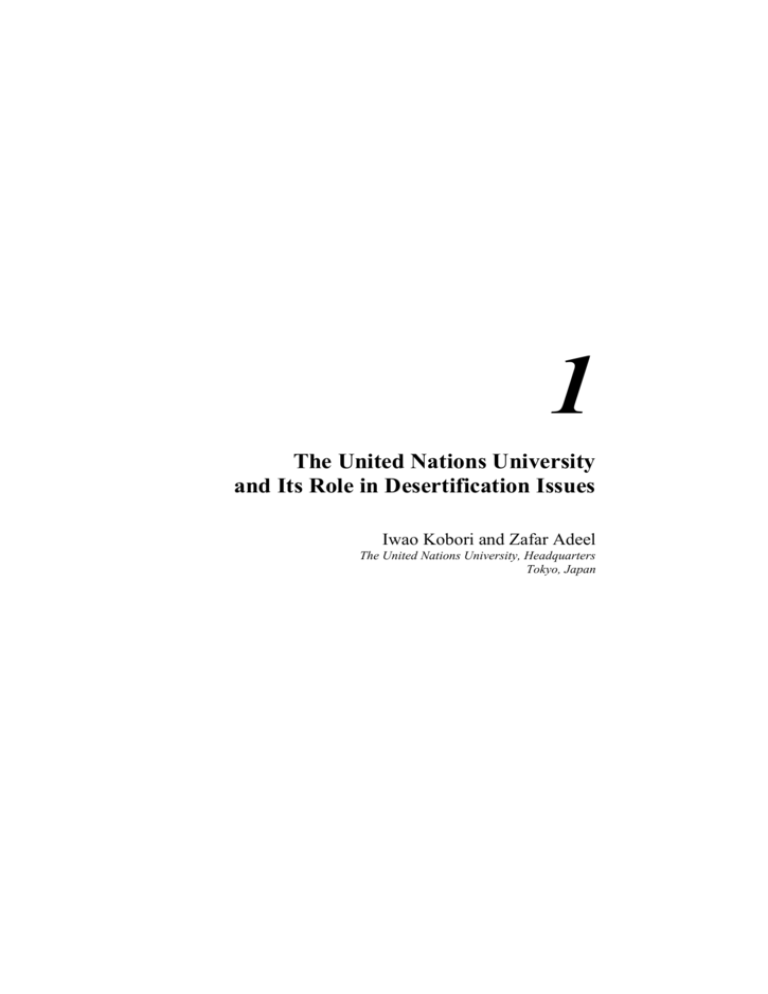
1 The United Nations University and Its Role in Desertification Issues Iwao Kobori and Zafar Adeel The United Nations University, Headquarters Tokyo, Japan 2 Kobori and Adeel Introduction The United Nations University (UNU), as an autonomous organization under the United Nations umbrella, contributes to the goals of sustainable development set by the UN through research, advanced training, and dissemination of knowledge. It provides and manages a framework for bringing together the world’s leading scholars to tackle pressing global problems. In particular, it helps alleviate the isolation of researchers in developing countries. Additionally, the UNU works in collaboration with existing academic and research institutions in the various parts of the world. It also works closely with the UN Secretariat, UNESCO and other UN organizations, acting as a link to the academic community and serving as a think tank for the entire UN system. On the whole, the UNU takes a multidisciplinary approach towards investigating pressing global issues, ensuring a broad range of viewpoints. Environment and sustainable development issues are an example of this approach, which have featured centrally in UNU’s programme since its inception more than 20 years ago. In this context, issues related to desertification have also been an important element of the activities at the UNU. This paper provides an overview of the activities directly linked to the issues pertaining to land degradation and desertification. Several symposia and conferences that have taken place under the UNU umbrella are highlighted. Some of these scientific meetings have led to publication of the findings and their dissemination. Based on this contextual involvement with these issues, UNU’s role in desertification issues is identified in this paper. In this regard, some key activities are recognized that should be undertaken with UNU providing the leadership and resources. Background A major milestone in the context of desertification issues was the United Nations Conference on Environment and Development UNCED (1992), organized in Rio de Janeiro. A significant outcome of the conference, also known as the Earth Summit, was the development of Agenda 21. In Chapter 12 of Agenda 21, the desertification issues are clearly presented and their importance in achieving sustainable development is highlighted. This was also the first time that a formal definition of desertification was adopted: “Desertification is land degradation in arid, semi-arid and dry sub-humid areas resulting from various factors, including climatic variations and human activities.” In order to meet the challenges posed by desertification problems, the following programme areas were identified within the Chapter 12 of Agenda 21: Knowledge base, including information and monitoring systems, Intensified soil conservation, afforestation and reforestation, Eradication of poverty and promotion of alternative livelihood, UNU’s Role in Desertification Issues 3 Comprehensive national anti-desertification programmes, Comprehensive drought preparedness and drought-relief schemes, and Popular participation and environmental education. These provisions in the Agenda 21 led to an in-depth discussion of various issues at an intergovernmental level, which was formally initiated in May 1993. The main purpose of these intergovernmental negotiations was to elaborate an international convention to combat desertification in those countries experiencing serious drought and/or desertification, particularly in Africa. The UN Convention to Combat Desertification (UNCCD) was formally adopted on 17 June, 1994 and opened for signature on 15 October, 1994. Its 50th ratification came on 26 September, 1996, leading to its entry into force by 26 December 1996. To date, 145 countries have signed and ratified the convention. Within the UNCCD, the overall approach for combating desertification is identified. The key elements of this approach are: 1. 2. 3. 4. Innovation is the key: New and innovative solutions to the problems posed by desertification have to be sought. This means that a bottom-up approach for development of technologies has to be adopted. Additionally, there has to be a significant transfer of technology from the developed countries to the developing countries. Emphasis on sustainability: The various methods adopted for combating desertification should be truly sustainable as a long-term measure. Short-term and quick-fix solutions have to be avoided. National Action Programmes: The member countries have to develop national action programmes to combat desertification. This should involve development of long-term strategies and policies, and integration with other national development plans. There should be an emphasis on involvement of local communities in developing and implementing specific measures to combat desertification. In general, the national governments have to provide conditions inducive for combating desertification, including allocation of financial resources. Partnership Agreements: There have to be regional agreements to address issues related to transboundary problems. This convention, thus provides a suitable framework for implementing specific measures to combat desertification. It is important to point out that the emphasis on the regional nature of desertification problems is present in the convention. Similarly, the involved parties are urged to seek innovative solutions to the problems faced. In this respect, it should be realized that there is also a close linkage between desertification and other existing regimes at the international and global scale. These include: Biodiversity Issues: The efforts to combat desertification are closely linked to conservation of biodiversity, particularly in arid and hyper-arid lands. 4 Kobori and Adeel Wildlife Protection: Also related to biodiversity conservation, the protection of wildlife in arid lands is an important issue when designing efforts to combat desertification. Climate Change Impacts: The changes in climate can profoundly affect (positively or negatively) the extent and level of desertification, particularly when focusing on climate change as a result of anthropogenic activities. Food Security (and land resources): Another key element of efforts to combat desertification is to preserve the land as a resource for food production and livelihood. Significant efforts are, thus, focused on ensuring food security in arid lands. On the whole, the UNCCD has provided the backdrop for the activities related to desertification undertaken at the UNU. However, it is important to point out that the UNU was actively involved in these issues even prior to the existence of the convention. These activities can be classified into three broad categories: (a) international conferences, symposia and workshops; (b) papers written for and presented at UNU; and (c) books published by UNU. Although, the some of the publications are interlinked with the workshops and symposia, each one of these categories is discussed here individually. Conferences, Symposia and Workshops: UNU had organized a number of workshops during the late 1970s and during the 1980s to focus on issues related to desertification, land degradation and sustainable development in arid lands. These include: a workshop held in Chiang Mai, Thailand in 1978 (Ives et al., 1980); a workshop held in Hamburg, Germany in 1979 (Mabbutt, 1980); a workshop held in Tuscon, Arizona, USA in 1979 (Mabbutt et al., 1980a); a workshop held in Coahuila, Mexico in 1980 (Mabbutt et al., 1980b); a workshop held in Gaborone, Botsawana in 1982 (Arntzen et al., 1986); an international symposium held in Tokyo, Japan in 1992 (UNU, 1992); and a seminar on Aral Sea held in Tokyo, Japan in 1995 (UNU, 1995). Additionally, a special meeting on desertification was organized as a part of the 20th International Geographical Congress held in Japan (1980). This meeting, supported by UNU and UNESCO, was held at the foot of Mount Fuji. It included a presentation by Dr. Chao Sung Chiao which provided a detailed description of Chinese deserts and related issues. In 1995, UNU organized a symposium on the Central Asian water crisis, with a particular focus on three enclosed seas: Aral, Caspian and Dead Seas. Among other leading experts, two Iranian specialists gave presentations on the Caspian Sea issues. In 1996, UNU organized another workshop on arid lands: “Fresh Water in Arid Lands.” These meetings resulted in publication of books by UNU Press that provide an excellent overview of the problems related to these three seas. In parallel to the activities described above, UNU has collaborated with international institutions such as the Chinese Academy of Sciences. As an example, this collaboration has provided opportunity for Chinese scholars to visit Japan. The so-called south-south programme has resulted in similar UNU’s Role in Desertification Issues 5 collaborations. UNU has supported researchers in developing countries to visit other developing countries with same environmental and scientific background. For example, in the case of using biomass in semi-arid regions, UNU sent Indian researchers to Africa to help assist the technology transfer. More significantly, UNU co-sponsored the UNCCD meeting on Desertification and the Role of NGO’s. This meeting was held at the UNU Headquarters in Tokyo in 1997. This meeting has indirectly provided an excellent linkage to the convention secretariat and may lead to close collaborations in the future. Paper Presentations and Related Publications: Several lectures presented in the UNU Open Forum have focused on desertification issues. These lectures have also been published as stand-alone papers by the UNU Press. These include an overview paper on the myths and facts related to desertification by Prof. Monique Mainguet (Mainguet et al., 1996). Also related are the papers presented by Dr. François Doumenge (Doumenge, 1997) and Dr. Arie Issar (Issar, 1997). Dr. Doumenge discussed the problems faced in the Mediterranean Sea area, whereas Dr. Issar focused on the projected impacts of climate change. Books Published: Over the years, several books have been published by UNU on subjects directly related to desertification issues. The topics cover a wide range of subject areas, including: overview of desertification issues (Heathcote, 1980), water resource management (Murakami, 1995; Uitto and Schneider, 1997), land resource utilization (Ruddle and Chuanjun, 1983), ecosystems and technology development (Cordes and Scholz, 1980; Burley, 1982; Spooner, 1984; Davies 1985; Parkes et al., 1985), regions at risk from land degradation (Kasperson et al., 1995), and water management for enclosed seas (Kobori and Glantz, 1998). It is obvious that these publications do not cover all the aspects of desertification, yet they form a worthwhile collection of reference documents. Network Development We must recognize that UNU is quite different in its function and operation from other UN organizations. Particularly, it is important to understand the fact that developing networks among researchers and scholars is a key mode of operation for UNU. For developing countries, this also eventually leads to capacity building in terms of their human resources. Organizing workshops and symposia on a regular basis is an effective means of establishing and maintaining these researcher networks. With this goal in view, the Environment and Sustainable Development programmes at UNU has organized several workshops in connection with desertification issues. 6 Kobori and Adeel This Tehran symposium and workshop marks the development of a relatively new network within UNU to focus on desertification issues. It is important to point out that desertification issues impact several different fields of knowledge; which include technology development, social sciences, environmental sciences, and sustainable development. Therefore, the structure of this network has to be flexible and multidisciplinary in its approach. It is hoped that these UNUsponsored workshops will help crystallize such a network of researchers and scholars. Proposed Future Directions Considering the importance of desertification issues, UNU is seeking a more active role in research and technology dissemination related to desertification. To achieve its goals, UNU proposes several mechanisms: Development of a Network of Researchers – The geographical area of focus includes Northern Africa, Middle East, Central Asia and China. Capacity Building – This can be achieved through the training workshops and information dissemination, particularly focussing on young professionals and decision-makers in developing countries. Holding International Workshops and Symposia – The focus of these issues will be on management of desertification problems within the network region with a particular emphasis on water management. Publishing a Series of Proceedings – The technical papers presented at the symposia and other highlights of the workshop will be combined into these proceedings for dissemination purposes. It should be pointed out that several other UN organizations are already engaged in various aspects of desertification, either directly or indirectly. These include UNCCD, UNESCO, UNEP, WHO, WMO, FAO, UNSO, and CGIAR group. Global financial institutions, such as UNDP, World Bank, and IFAD are also involved. Furthermore, we should not forget the role of NGO’s that have been working in this field. The role of UNU has to be viewed in this context. The small organizational size of UNU means limited resources for activities. However, it is an institution that emphasizes academic excellence in the work done under its umbrella and is academically “neutral.” Additionally, there are several Research and Training Centres and Programmes (RTC/Ps) working under the UNU Headquarters which may support research on desertification issues, these include: Institute of Advance Studies (UNU/IAS; Tokyo, Japan), Institute for Natural Resources in Africa (UNU/INRA; Accra, Ghana), International Leadership Academy (UNU/ILA; Amman, Jordan), International Network on Water, Environment and Health (UNU/INWEH; Ontario, Canada), and World Institute for Development Economics Research (UNU/WIDER; Helsinki, Finland). UNU’s Role in Desertification Issues 7 References Arntzen, J.W., L.D. Ngcongco, and S.D. Turner, (Eds.), 1986. Land Policy and Agriculture in Eastern and Southern Africa. Selected papers presented at a workshop held in Gaborone, Botswana, 14-19 February, 1982. NRTS28/UNUP-604; The United Nations University: 150 pp. Burley, J., 1982. Obstacles to Tree Planting in Arid and Semi-Arid Lands: Comparative Case Studies from India and Kenya. NRTS-18/UNUP-391; The United Nations University, Tokyo: 52 pp. Cordes, R., and F. Scholz, 1980. Bedouins, Wealth and Change – A Study of Rural Development in the United Arab Emirates and the Sultanate of Oman. NRTS-7/UNUP-143; The United Nations University, Tokyo: 65 pp. Davies, H.R.J., (Ed.), 1985. Natural Resources and Rural Development in Arid Lands: Case Studies from Sudan. NRTS-24/UNUP-504; The United Nations University, Tokyo: 84 pp. Doumenge, F., 1997. The Mediterranean Crises. The United Nations University Lectures – 16. United Nations University Press, Tokyo. Gallais, J. 1982. Compte Rendu du Seminaire sur la Gestion des Terres Arides en Afrique de l’Ouest. NRTS-19F/UNUP-421; The United Nations University, Tokyo: 80 pp. Heathcote, R.L., (Ed.), 1980. Perception of Desertification. NRTS-10/UNUP190; The United Nations University, Tokyo: 134 pp. Issar, A.S., 1997. Climate Change: Is it a Positive or a Negative Process? The United Nations University Lectures – 17. United Nations University Press, Tokyo. Ives, J.D., S. Sabhasri, and P. Voraurai, (Eds.) 1980. Conservation and Development in Northern Thailand. Proceedings of a Programme Workshop on Agro-Forestry and Highland-Lowland Interactive Systems; Held at Chiang Mai, Thailand, 13-17 November 1978. NRTS3/UNUP-77; The United Nations University, Tokyo: 114 pp. Kasperson, J.X., R.E. Kasperson, and B.L. Turner II, (Eds.) 1995. Regions at Risk: Comparisons of Threatened Environments. UNU Studies on Critical Environmental Regions. United Nations University Press, Tokyo: 588 pp. Kobori, I., and M.H. Glantz, (Eds.), 1998. Central Eurasian Water Crisis: Caspian, Aral and Dead Seas. Water Resources Management and Policy. United Nations University Press, Tokyo: 203 pp. Mabbutt, J.A., (Ed.), 1980. Research and Training for Management of Arid Lands – With Special Reference to Anglophone Africa and the University of Khartoum. Proceedings of a Workshop Held at the Institute of Geography, University of Hamburg, Federal Republic of Germany, 29 October – 2 November 1979. NRTS-13/UNUP-198; The United Nations University, Tokyo: 48 pp. Mabbutt, J.A., and A.W. Wilson, (Eds.), 1980. Social and Environmental Aspects of Desertification. Proceedings of an Inter-Congress Meeting of the International Geographical Union Working Group on Desertification in and around Arid Lands; Held in conjunction with the Arid Lands Sub- 8 Kobori and Adeel programme of the United Nations University Natural Resources Programme, and the UNESCO/MAB Programme, 3-8 January 1979, Tuscon, Arizona, USA. NRTS-5/UNUP-127; The United Nations University, Tokyo: 40 pp. Mabbutt, J.A., H.J. Schneider, and R. Nava, (Eds.), 1980. Strategies for Improved Management of Latin American Drylands. Report of a Workshop held in the Department of Renewable Resources, Autonomous Agricultural University, Saltillo, Coahuila, Mexico, 25-29 February 1980. NRTS14/UNUP-227; The United Nations University, Tokyo: 29 pp. Mabbutt, J.A., H.J. Schneider, and R. Nava, (Eds.), 1981. Estrategias para mejorar el manejo de las regiones aridas de America Latina. Informe de la s mesa de trabajo realizada en el Departmento Recursos Naturales Renovables de la Universidad Autonoma Agraria, Saltillo, Coahuila, Mexico, 25-29 de febrero de 1980. NRTS-14S/UNUP-239; The United Nations University, Tokyo: 26 pp. Mainguet, M., K. Mersmann, and M. Visser, 1996. Man-Induced Desertification. The United Nations University Lectures – 12. United Nations University Press, Tokyo: 24 pp. Murakami, M., 1995. Managing Water for Peace in Middle East – Alternative Strategies. United Nations University Press, Tokyo: 320 pp. Parkes, D.N., I.H. Burnley, and S.R. Walker, 1985. Arid Zone Settlement in Australia: A Focus on Alice Springs. NRTS-26/UNUP-506; The United Nations University, Tokyo: 129 pp. Ruddle, K., and W. Chuanjun, (Eds.), 1983. Land Resources of the People’s Republic of China. Resource Systems Theory and Methodology Series, No. 5. NRTS-16/UNUP-349; The United Nations University, Tokyo: 84 pp. Spooner, B., 1984. Ecology in Development: A Rationale for Three-Dimensional Policy. NRTS-21/UNUP-458; The United Nations University, Tokyo. 58 pp. Thimm, H-U., 1979. Development Projects in the Sudan: An Analysis of their Reports with Implications for Research and Training in Arid Land Management. NRTS-1/UNUP-42; The United Nations University, Tokyo: 59 pp. Uitto, J.I., and J. Schneider, (Eds.), 1997. Freshwater Resources in Arid Lands. United Nations University Press, Tokyo: 108 pp. UNU, 1980. Seminaire sur l’energie solaire pour les communautes rurales; Alger, du 15 au 21 avril 1978. Organisme Nationale de la Recherche Scietifique, Algerie – l’Universite des Nations Unies. NRTS-8F/UNUP185, The United Nations University, Tokyo: 45 pp. UNU, 1992. Environmental Management of the Aral Sea Region – Finding Solutions to One of the World’s Major Environmental Disasters. Report of the International Symposium held at UNU Headquarters Building, Tokyo, Japan, 29 September, 1992. UNU, 1995. Report of the Seminar on the Aral Crisis. Second UNU/GIF Meeting on the Environmental Management of the Aral Sea Region. The United Nations University and Global Infrastructure Fund Research Foundation Japan.
